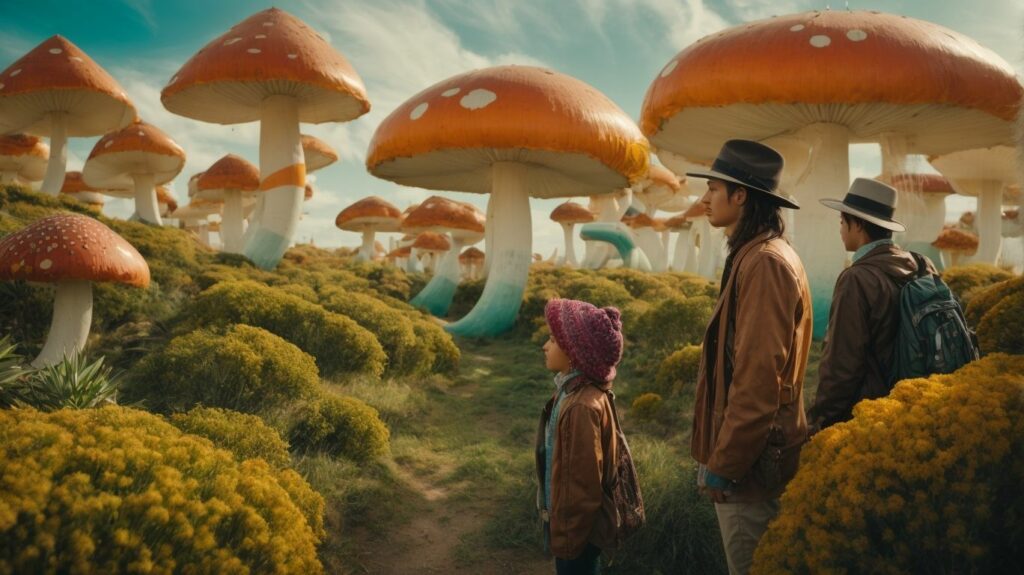Are you considering trying shrooms, but worried about potential side effects? You’re not alone. The growing popularity of psilocybin mushrooms has sparked concerns about their safety and potential risks. In this article, we’ll dive into the potential side effects of shrooms and provide important information to help you make an informed decision.
What Are Shrooms?
Shrooms, also known as magic mushrooms, are a type of fungi that contain the psychoactive compound psilocybin. They have been used for centuries in spiritual and medicinal practices due to their hallucinogenic effects. Shrooms can cause altered perceptions, intense mood changes, and sensory distortions. The effects can vary depending on the dosage, individual tolerance, and environment. It is important to note that shrooms can also have potential risks and side effects, such as anxiety, paranoia, and increased heart rate. It is advised to use them in a safe and controlled environment.
True story: A friend once shared their experience with shrooms, describing a profound sense of connection with nature and a heightened appreciation for art and music. They also mentioned feeling a deep sense of introspection and gained insights into their own thoughts and emotions. However, they emphasized the importance of being well-informed about What Shrooms Are, having a trusted trip-sitter, and respecting the substance to ensure a positive and safe experience.
How Do Shrooms Affect the Brain?
Psilocybin, the active compound in magic mushrooms, has various effects on the brain. Here are the steps to understand how shrooms impact the brain:
- Psilocybin is converted into psilocin, which binds to serotonin receptors in the brain.
- As a result, serotonin levels are altered, leading to changes in mood, perception, and cognition.
- Psilocybin increases connectivity between different brain regions, promoting the formation of new neural pathways and enhancing creativity.
- Shrooms can also induce a mystical or spiritual experience, which can lead to long-lasting positive changes in personality and well-being.
- However, improper use or high doses can cause adverse effects such as anxiety, paranoia, and a temporary loss of touch with reality.
Understanding the effects of shrooms on the brain is crucial for safe and responsible use.
What Are the Potential Side Effects of Shrooms?
Before considering taking shrooms, it is important to understand the potential side effects that may arise from their use. These can be divided into three categories: physical, psychological, and long-term effects. In this section, we will discuss each of these categories in detail, providing insight into the potential risks and precautions to take when consuming shrooms. By being aware of the possible side effects, one can make an informed decision about whether or not to use shrooms.
1. Physical Side Effects
Physical side effects of consuming shrooms can vary in severity and duration. It is important to be aware of these potential effects to make informed decisions about their use.
- Unpleasant feelings of nausea and vomiting
- Stomach cramps and discomfort
- Increased heart rate
- Elevated blood pressure
- Loss of coordination and balance
- Dilated pupils
- Excessive sweating
- Tremors and muscle tension
- Headaches
Be careful, shrooms may make your thoughts a little too magical and your emotions a little too intense.
2. Psychological Side Effects
Psychedelic mushrooms can have a range of psychological side effects, which may vary depending on the individual and dosage. These potential side effects include:
- hallucinations
- altered perception of time and space
- intense emotions
- spiritual or mystical experiences
- changes in mood and thought patterns
It is important to be mindful of these effects and approach the use of mushrooms with caution. To minimize the risk of negative psychological side effects, it is advised to consume mushrooms in a safe and comfortable environment, start with a low dose, and have a trusted trip sitter present.
3. Long-term Side Effects
Long-term side effects of shrooms can occur after repeated or high-dose use. These effects can vary from person to person, but may include:
- Psychological distress or flashbacks, known as hallucinogen persisting perception disorder (HPPD)
- Changes in personality or mood
- Impaired memory and cognitive function
- Increased risk of mental health disorders, such as psychosis or depression
- Dependency or addiction
To reduce the risks of long-term side effects:
- Use shrooms in moderation and avoid frequent or high-dose use
- Understand your personal sensitivity to psychedelics and adjust dosage accordingly
- Create a safe and comfortable setting for your trips
- Consider integrating therapy or counseling to process and integrate your experiences
- Limit or avoid mixing shrooms with other substances
Remember, everyone’s experience with shrooms can differ, so always prioritize your safety and well-being. Just like a bad date, dosage, individual sensitivity, and setting can all affect the intensity of shroom side effects.
What Factors Can Influence the Severity of Shroom Side Effects?
When it comes to consuming magic mushrooms, many factors can influence the severity of side effects experienced. These factors can vary greatly and include the dosage taken, individual sensitivity, and the setting in which the mushrooms are consumed. Understanding how these factors can impact the effects of shrooms is crucial for anyone considering trying them. In this section, we will delve into each of these factors and their potential impact on the overall experience of consuming magic mushrooms.
1. Dosage
When consuming shrooms, it is crucial to consider the appropriate dosage to ensure a safe and enjoyable experience.
- Start with a low dosage: Begin with a small amount, typically around 1 to 2 grams, to gauge your sensitivity to the substance.
- Gradually increase if necessary: If the initial dosage is well-tolerated, you can gradually increase by 0.5 to 1 gram to achieve the desired effects.
- Be mindful of potency: Different species and strains of mushrooms have varying levels of potency, so it’s important to know the strength of the specific mushrooms you are consuming.
- Understand personal tolerance: Each individual may have different sensitivities to psilocybin, so it’s essential to be aware of your own tolerance level.
- Consider the setting: The setting in which you consume shrooms can also impact the experience, so choose a comfortable and safe environment.
2. Individual Sensitivity
Individual sensitivity plays a crucial role in how shrooms affect the brain and body. Here are steps to consider when it comes to individual sensitivity:
- Start with a low dosage to gauge your reaction.
- Take note of any personal history or experiences that may impact your sensitivity, especially in regards to individual sensitivity.
- Monitor your body’s reaction to shrooms, paying attention to any unusual or intense effects.
- Consult with a healthcare professional if you have any concerns about your individual sensitivity.
- Always prioritize your safety, and if you experience any adverse reactions, seek medical help immediately.
3. Setting
The setting plays a crucial role in the experience of consuming shrooms. Here are some steps to consider when setting the stage for a safe and positive trip:
- Create a comfortable and familiar environment.
- Choose a quiet and peaceful location to minimize distractions.
- Surround yourself with trusted and supportive individuals who can help guide you through your journey.
- Avoid crowded or unfamiliar places that may induce anxiety.
- Engage in activities that promote relaxation and introspection, such as listening to calming music or meditating.
Are There Any Benefits of Shrooms?
Are There Any Benefits of Shrooms?
There are several potential benefits of consuming shrooms, also known as magic mushrooms. These mushrooms contain psychoactive compounds like psilocybin, which have been found to induce profound mental effects. Research suggests that shrooms may have therapeutic potential in treating conditions such as depression, anxiety, and addiction. They have also been found to enhance mood, increase creativity, and promote spiritual experiences in some individuals. However, it is crucial to note that the use of shrooms should be approached with caution due to their hallucinogenic effects and potential risks. It is always recommended to consult a healthcare professional before using shrooms for any purpose.
Sarah, a 32-year-old woman, struggled with treatment-resistant depression for years. After conducting extensive research and receiving guidance from a therapist, she made the decision to explore psilocybin therapy using shrooms. Under controlled conditions and with professional supervision, she experienced profound insights, emotional healing, and a significant reduction in depressive symptoms. Sarah’s journey with shrooms, combined with therapy and integrative support, has allowed her to reclaim her life and find hope in her battle against depression.
How Can the Risks of Shroom Side Effects Be Reduced?
As with any mind-altering substance, there are potential risks and side effects that come with consuming shrooms. However, there are steps that can be taken to minimize these risks and have a more positive and safe experience. In this section, we will discuss five ways to reduce the chances of experiencing adverse effects from shrooms. From being mindful of the source and quality of shrooms to having a trusted trip sitter, each step plays a crucial role in ensuring a safer and more enjoyable shroom journey.
1. Know the Source and Quality of Shrooms
Knowing the origin and quality of shrooms is essential for ensuring safety and minimizing risks. Here are steps to follow:
- Research reputable suppliers and growers that prioritize quality control and safety measures.
- Look for certifications or third-party lab testing to verify the purity and potency of the shrooms.
- Read reviews and seek recommendations from experienced users or trusted communities.
- Inspect the mushrooms for visual characteristics like color, texture, and any signs of contamination or decay.
- Consider growing your own mushrooms using trusted spores or kits for better control over the sourcing and quality.
True story: A friend once purchased shrooms from an unknown source and experienced severe side effects. After that incident, they learned the importance of knowing the origin and quality of shrooms to prioritize their well-being and have since only obtained them from reputable suppliers.
2. Take a Safe and Comfortable Setting
Creating a safe and comfortable setting is crucial when consuming shrooms to minimize potential risks and ensure a positive experience. Here are some steps to take:
- Choose a familiar and calm environment, such as your home or a trusted friend’s place, to take your shrooms.
- Ensure that the space is clean, organized, and free of any potential hazards.
- Set up a comfortable seating area with pillows, blankets, and ambient lighting to create a safe and comfortable atmosphere.
- Remove any sharp objects or dangerous substances from the area to prevent any accidents.
- Play soothing and calming music to further enhance the calming and comfortable environment.
3. Start with a Low Dosage
To minimize the potential risks and side effects of consuming shrooms, it is important to follow these steps when starting with a low dosage:
- Research: Learn about the effects and risks of shrooms.
- Consultation: Talk to a healthcare professional to ensure it is safe for you.
- Source: Obtain shrooms from a trusted and reputable supplier.
- Preparation: Create a safe and comfortable environment for your trip.
- Start with a Low Dosage: Begin with a low dose to gauge your tolerance and reaction.
- Observation: Stay mindful of any physical or psychological changes.
- Gradual increase: If desired, gradually increase the dosage over time.
- Trip sitter: Have a trusted person present to provide guidance and support.
- Avoid mixing: Refrain from combining shrooms with other substances.
Because let’s be real, who wants to be stuck with a paranoid friend while you’re in another dimension?
4. Have a Trusted Trip Sitter
Having a trusted trip sitter is crucial when consuming shrooms to ensure safety and support. Here are steps to follow:
- Choose someone you trust who is experienced with psychedelics.
- Ensure they are fully informed about the effects and risks of shrooms.
- Discuss your intentions, fears, and expectations with them beforehand.
- Ask them to remain sober throughout the experience to provide guidance and assistance if needed.
- Set up a safe and comfortable environment for the trip.
- Establish clear communication channels and create a plan for how to handle challenging situations.
Remember, having a trusted trip sitter can help create a positive and safe psychedelic experience.
5. Avoid Mixing with Other Substances
Mixing shrooms with other substances can have unpredictable and potentially dangerous effects. To reduce the risk of side effects, follow these steps:
- Research: Understand the potential interactions between shrooms and other substances, such as alcohol or antidepressants.
- Avoid Combining: Refrain from using shrooms alongside other drugs or medications, including the ones listed above.
- Know Your Limits: Stick to shrooms alone and avoid experimenting with multiple substances simultaneously.
- Consult a Professional: Seek guidance from a healthcare professional or a knowledgeable expert before mixing shrooms with any other substances.
- Stay Informed: Stay updated on current research and information regarding the effects of mixing shrooms with other substances, including the ones listed above.
Always prioritize your safety and well-being by avoiding the combination of shrooms with other substances, including the ones listed above.
Frequently Asked Questions
What are the common side effects of shrooms?
The most common side effects of shrooms include nausea, vomiting, stomach discomfort, and changes in perception, such as visual and auditory hallucinations.
Can shrooms cause long-term side effects?
There is a potential for shrooms to cause long-term side effects, especially with frequent or high doses. These can include persistent hallucinations, HPPD (Hallucinogen Persisting Perception Disorder), and flashbacks.
Are there any physical side effects of shrooms?
Yes, shrooms can cause physical side effects such as increased heart rate, elevated blood pressure, and dilated pupils. In rare cases, they can also lead to seizures or loss of consciousness.
Can shrooms interact with other medications or substances?
Yes, shrooms can interact with certain medications and substances, especially those that affect serotonin levels in the brain. This can lead to serotonin syndrome, which can be potentially dangerous.
What are the potential psychological side effects of shrooms?
Shrooms can have a range of psychological side effects, including anxiety, panic attacks, confusion, and paranoia. They can also worsen pre-existing mental health conditions.
Are there any safe ways to use shrooms to minimize side effects?
While the use of shrooms always carries some risk of side effects, there are ways to minimize these risks. These include using a small dose, having a trusted trip sitter present, and avoiding mixing shrooms with other substances.




